A Low-Profile Antenna for On-Body and Off-Body Applications in the Lower and Upper ISM and WLAN Bands
Abstract
1. Introduction
2. Design of Proposed Dual-Band CPW-Fed Antenna
2.1. Geometry of Antenna
2.2. Design Stages of Proposed Antenna
2.3. Parametric Analysis of Key Parameters
2.3.1. Lower Stub Responsible for 5.2 GHz Band
2.3.2. Length of the Radiator Responsible for 2.45 GHz Band
2.4. Numerical Analysis
3. Measured and Simulated Results of the Proposed Antenna
3.1. Measurement Setup
3.2. Scattering Parameter
3.3. Measured and Simulated Gain
3.4. Simulated Radiation Efficiency
3.5. Measured and Simulated Radiation Pattern
3.6. SAR Analysis
3.7. Comparison of Proposed Work with the Literature
4. Conclusions
Author Contributions
Funding
Institutional Review Board Statement
Informed Consent Statement
Data Availability Statement
Acknowledgments
Conflicts of Interest
References
- Hussain, M.; Naqvi, S.I.; Awan, W.A.; Ali, W.A.E.; Ali, E.M.; Khan, S.; Alibakhshikenari, M. Simple wideband extended aperture antenna-inspired circular patch for V-band communication systems. AEU Int. J. Electron. Commun. 2022, 144, 154061. [Google Scholar] [CrossRef]
- Lamultree, S.; Thanamalapong, W.; Dentri, S.; Phongcharoenpanich, C. Tri-Band bidirectional antenna for 2.4/5 GHz WLAN and Ku-band applications. Appl. Sci. 2022, 12, 5817. [Google Scholar] [CrossRef]
- Iqbal, J.; Illahi, U.; Khan, M.A.; Rauf, A.; Ali, E.M.; Bari, I.; Ali, H.; Khan, M.A.; Alibakhshikenari, M.; Dalarsson, M. A novel single-fed dual-band dual-circularly polarized dielectric resonator antenna for 5G Sub-6GHz applications. Appl. Sci. 2022, 12, 5222. [Google Scholar] [CrossRef]
- Khan, Z.; Memon, M.H.; Rahman, S.U.; Sajjad, M.; Lin, F.; Sun, L. A Single-Fed Multiband Antenna for WLAN and 5G Applications. Sensors 2020, 20, 6332. [Google Scholar] [CrossRef] [PubMed]
- Al Kharusi, K.W.S.; Ramli, N.; Khan, S.; Ali, M.T.; Halim, M.H.A. Gain enhancement of rectangular microstrip patch antenna using air gap at 2.4 GHz. Int. J. Nanoelectron. Mater. 2020, 13, 211–224. [Google Scholar]
- Zhao, Y.; An, W.; Luo, Y.; Li, S.; Xiong, L.; Yu, S. Low-profile antenna integrated with solar cells for the 2.4 GHz band. IEEE Antennas Wirel. Propag. Lett. 2021, 20, 443–447. [Google Scholar] [CrossRef]
- Al-Yasir, Y.I.A.; Alkhafaji, M.K.; Alhamadani, H.A.; Parchin, N.O.; Elfergani, I.; Saleh, A.L.; Rodriguez, J.; Abd-Alhameed, R.A. A New and Compact Wide-Band Microstrip Filter-Antenna Design for 2.4 GHz ISM Band and 4G Applications. Electronics 2020, 9, 1084. [Google Scholar] [CrossRef]
- Islam, M.S.; Islam, M.T.; Ullah, M.A.; Beng, G.K.; Amin, N.; Misran, N. A modified meander line microstrip patch antenna with enhanced bandwidth for 2.4 GHz ISM-band Internet of Things (IoT) applications. IEEE Access 2019, 7, 127850–127861. [Google Scholar] [CrossRef]
- Saravanan, M.; Rangachar, M.J.S. A narrowband corner slot patch antenna for 2.4 GHz wireless radio communications. Int. J. Eng. Technol. 2016, 8, 2149–2153. [Google Scholar]
- Geetharamani, G.; Aathmanesan, T. Design of metamaterial antenna for 2.4 GHz WiFi applications. Wirel. Pers. Commun. 2020, 113, 2289–2300. [Google Scholar] [CrossRef]
- Abdulhussein, A.M.; Khidhir, A.H.; Naser, A.A. 2.4 GHz Microstrip Patch Antenna for S-Band Wireless Communications. J. Phys. Conf. Ser. 2021, 2114, 012029. [Google Scholar] [CrossRef]
- Agarwal, R.; Saini, G. Optimized antenna for 5. 2GHz applications. Int. J. Comput. Appl. 2014, 98, 38–41. [Google Scholar] [CrossRef]
- Swapna, S.P.; Karthikeya, G.S.; Koul, S.K.; Basu, A. Three-port pattern diversity antenna module for 5.2 GHz ceiling-mounted WLAN access points. Prog. Electromagn. Res. C 2020, 98, 57–67. [Google Scholar] [CrossRef]
- Sharma, V.; Goel, A.; Upadhayay, M.D.; Singh, A.V. A Pi-shaped slot antenna for 5.2 GHz WLANMIMO application. IETE J. Res. 2021, 1–13. [Google Scholar] [CrossRef]
- Chaturvedi, D.; Kumar, A.; Raghavan, S. A nested SIW cavity-backing antenna for Wi-Fi/ISM band applications. IEEE Trans. Antennas Propag. 2019, 67, 2775–2780. [Google Scholar] [CrossRef]
- Gai, S.; Jiao, Y.C.; Yang, Y.B.; Li, C.Y.; Gong, J.G. Design of a novel microstrip-fed dual-band slot antenna for WLAN applications. Prog. Electromagn. Res. Lett. 2010, 13, 75–81. [Google Scholar] [CrossRef]
- Swetha, A.; Naidu, K.R. Miniaturised planar antenna with enhanced gain characteristics for 5.2 GHz WLAN application. Int. J. Electron. 2021, 108, 2137–2154. [Google Scholar] [CrossRef]
- Hussain, M.; Nadeem, N. A co-planer waveguide feed dual band antenna with frequency reconfigurability for WLAN and WiMax systems. In Proceedings of the 2019 International Conference on Electrical, Communication, and Computer Engineering (ICECCE), Swat, Pakistan, 24–25 July 2019; pp. 1–5. [Google Scholar]
- Tung, H.C.; Wong, K.L. A shorted microstrip antenna for 2.4/5.2 GHz dual-band operation. Microw. Opt. Technol. Lett. 2001, 30, 401–402. [Google Scholar] [CrossRef]
- Ahmad, S.; Paracha, K.N.; Sheikh, Y.A.; Ghaffar, A.; Butt, A.D.; Alibakhshikenari, M.; Soh, P.J.; Khan, S.; Falcone, F. A metasurface-based single-layered compact AMC-backed dual-band antenna for Off-Body IoT Devices. IEEE Access 2021, 9, 159598–159615. [Google Scholar] [CrossRef]
- Pachigolla, S.S.Y.; Kundu, S. Dual band printed wide-slot antenna for Wi-Fi and WLAN applications. In Proceedings of the 2020 URSI Regional Conference on Radio Science (URSI-RCRS), Varanasi, India, 12–14 February 2020; pp. 1–3. [Google Scholar]
- Gong, Q.; Xiao, M.; Luo, P.; Cui, Y. Dual-band horizontally/dual-polarized antennas for WiFi/WLAN/ISM applications. Microw. Opt. Technol. Lett. 2020, 62, 398–1408. [Google Scholar] [CrossRef]
- Hussain, M.; Jarchavi, S.M.R.; Naqvi, S.I.; Gulzar, U.; Khan, S.; Alibakhshikenari, M.; Huynen, I. Design and Fabrication of a Printed Tri-Band Antenna for 5G Applications Operating across Ka-, and V-Band Spectrums. Electronics 2021, 10, 2674. [Google Scholar] [CrossRef]
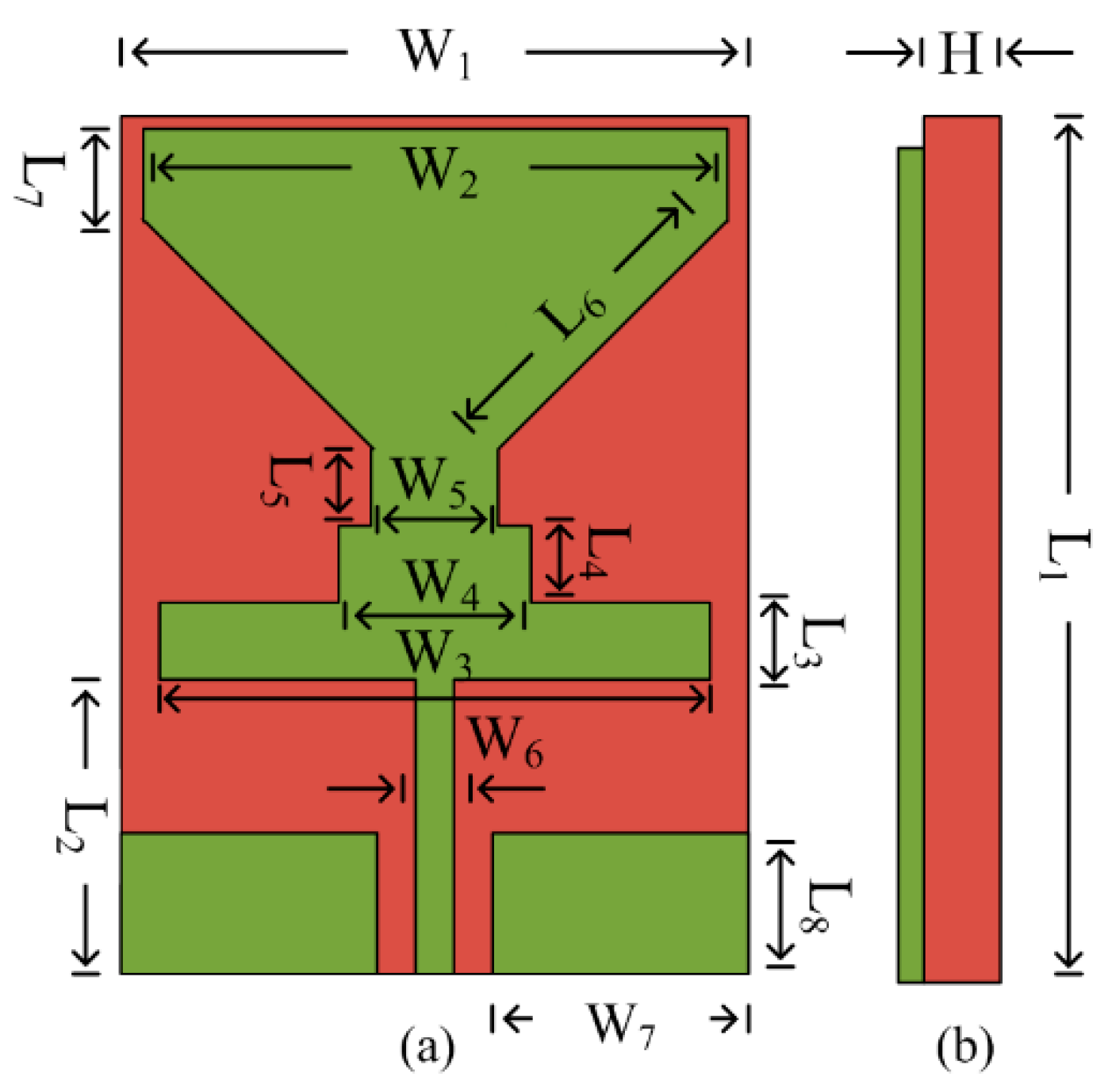

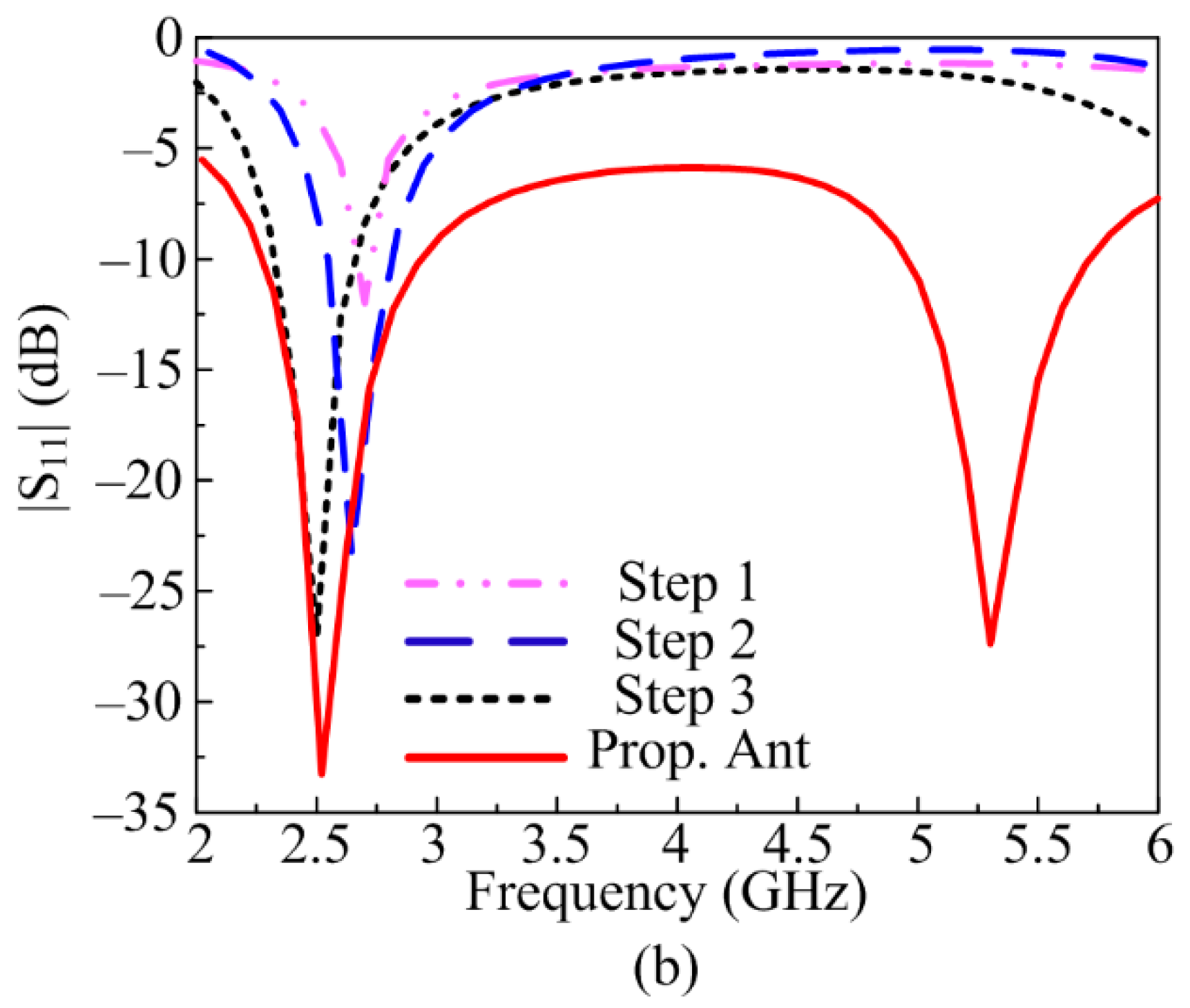
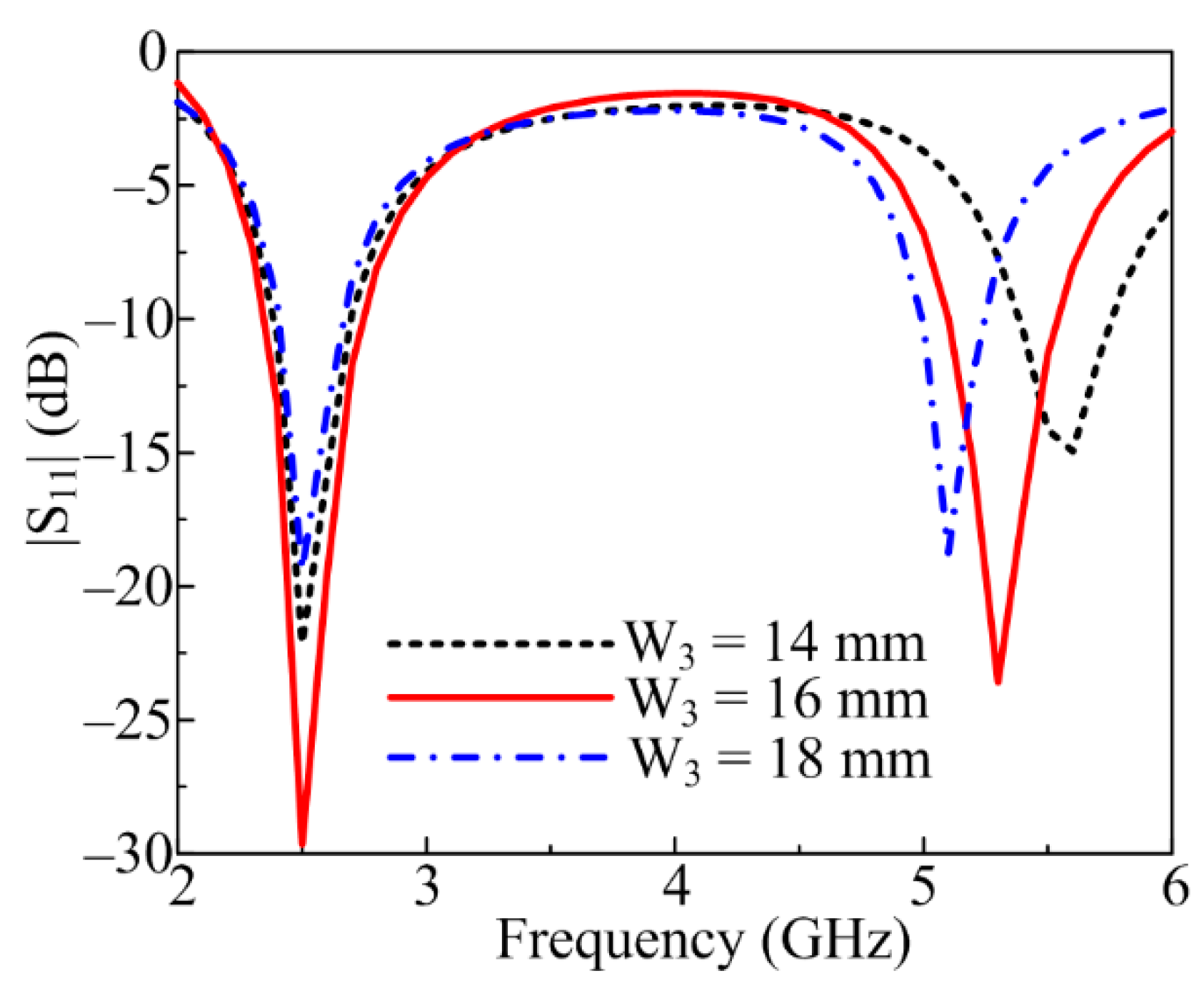
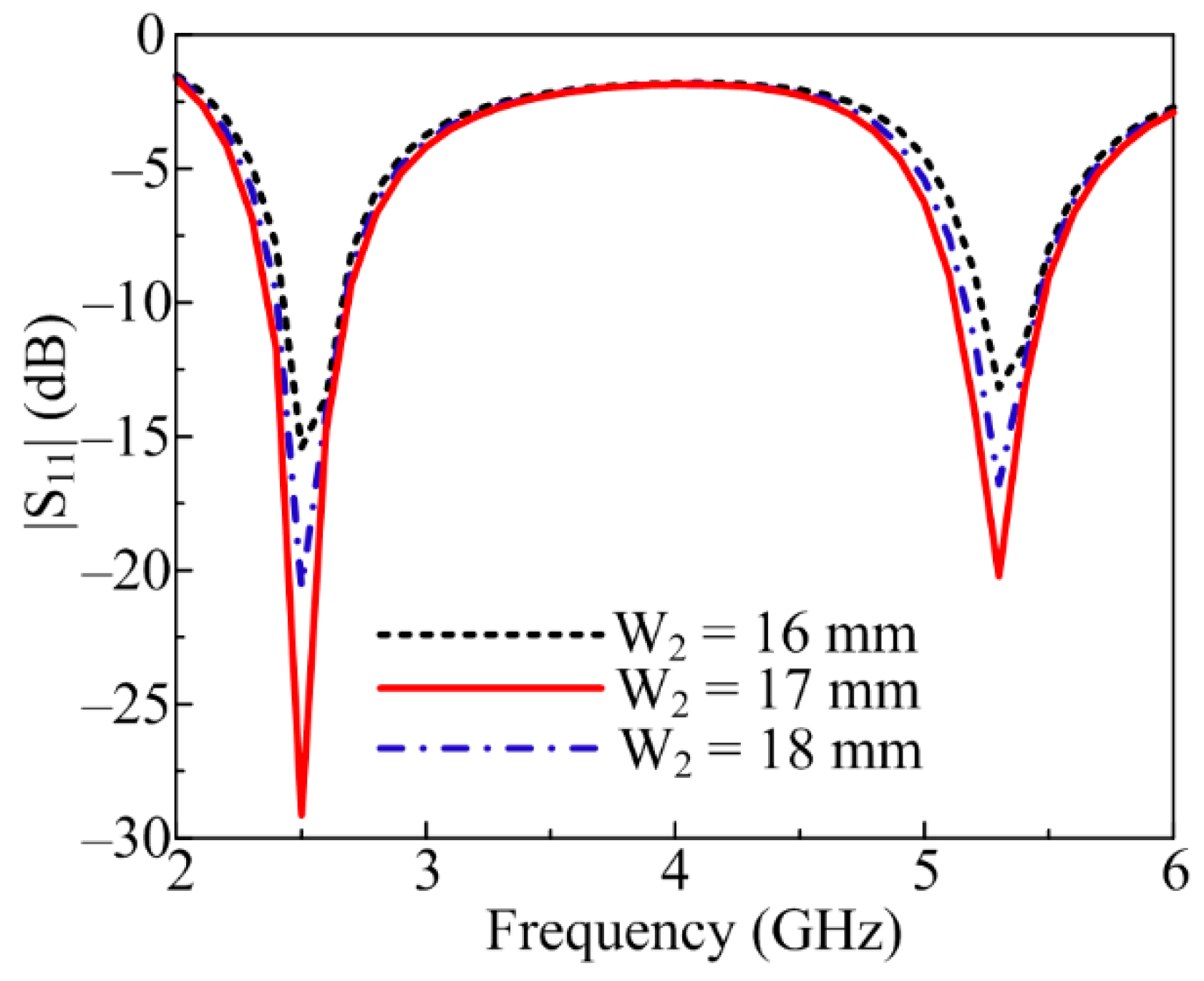

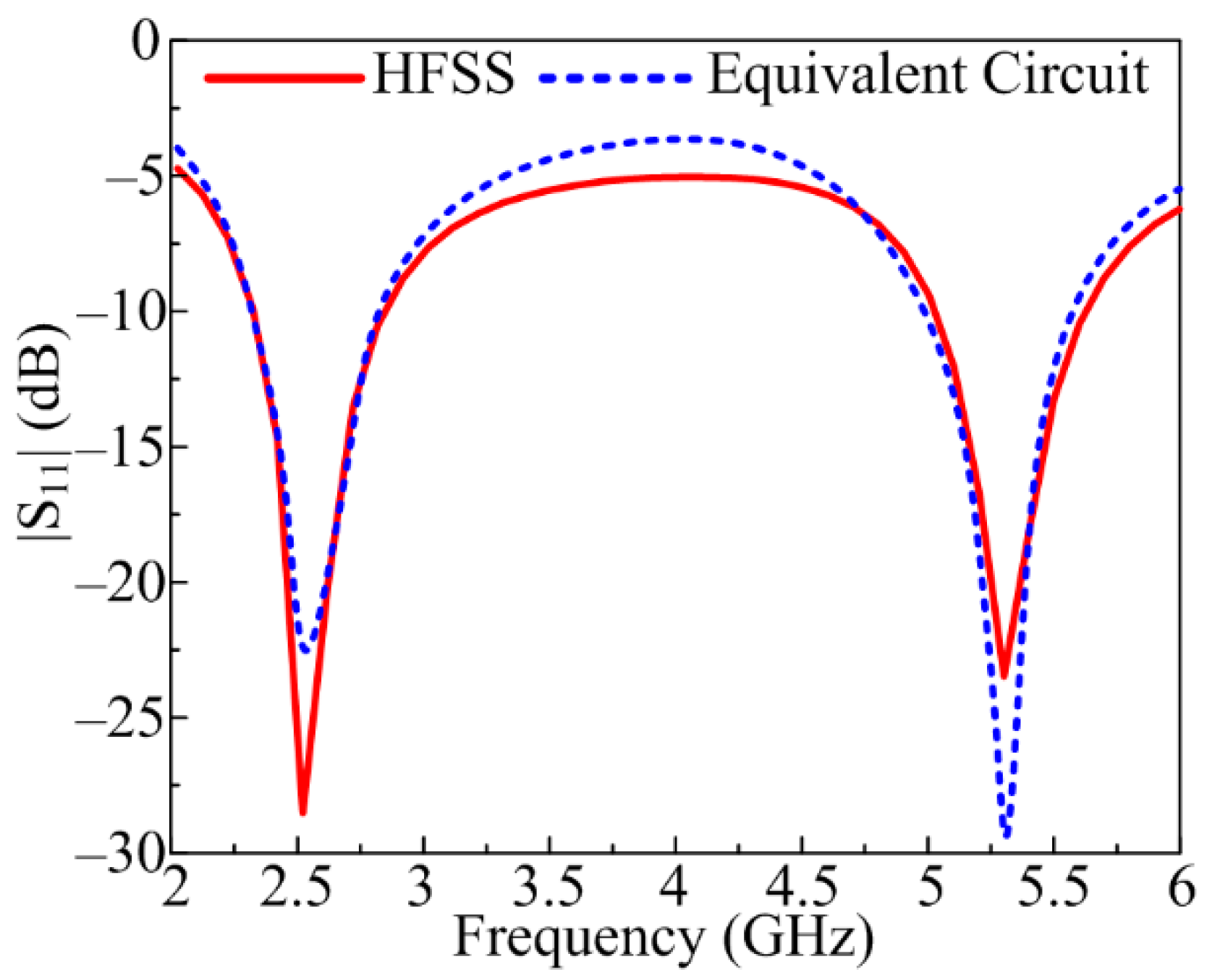
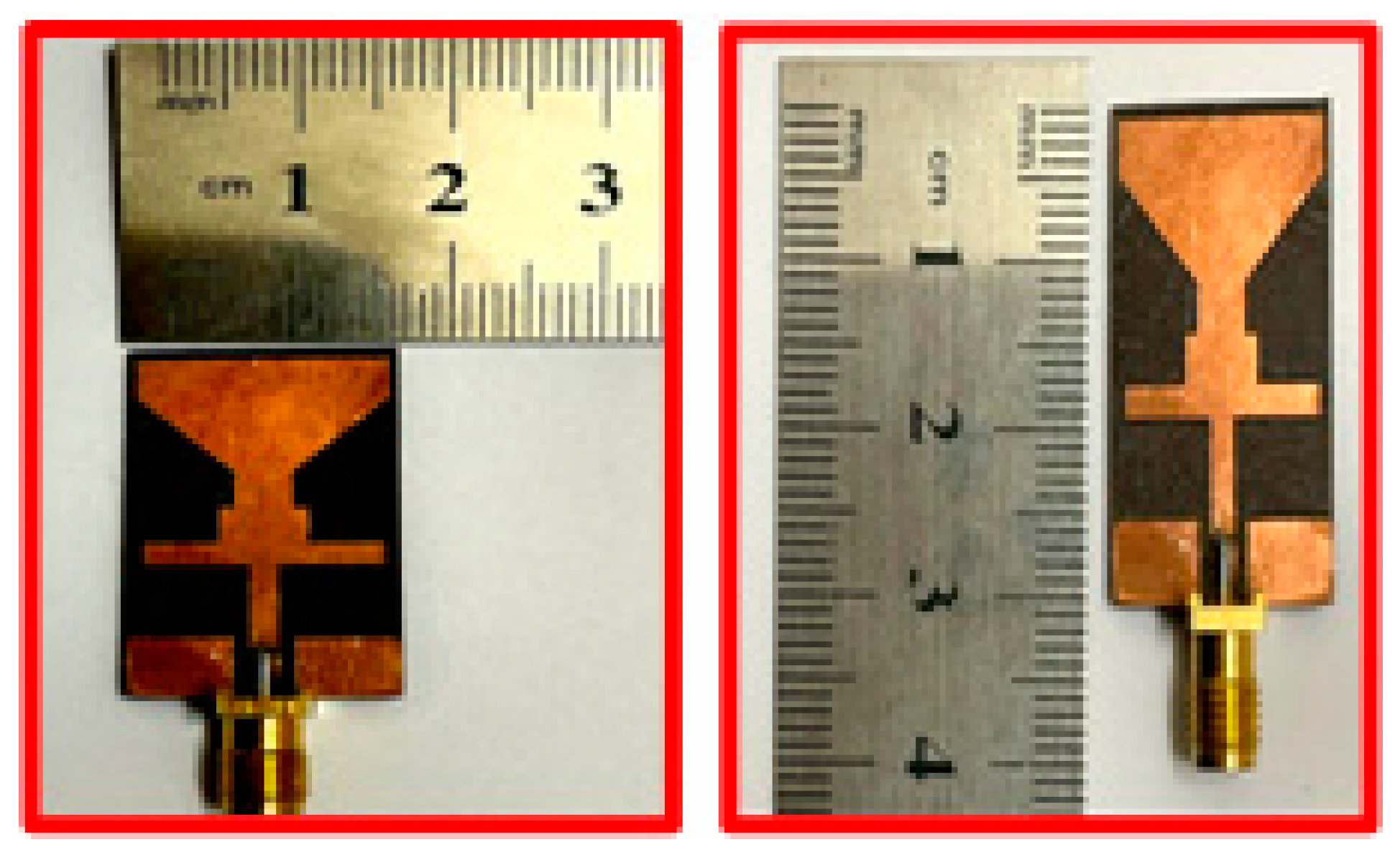
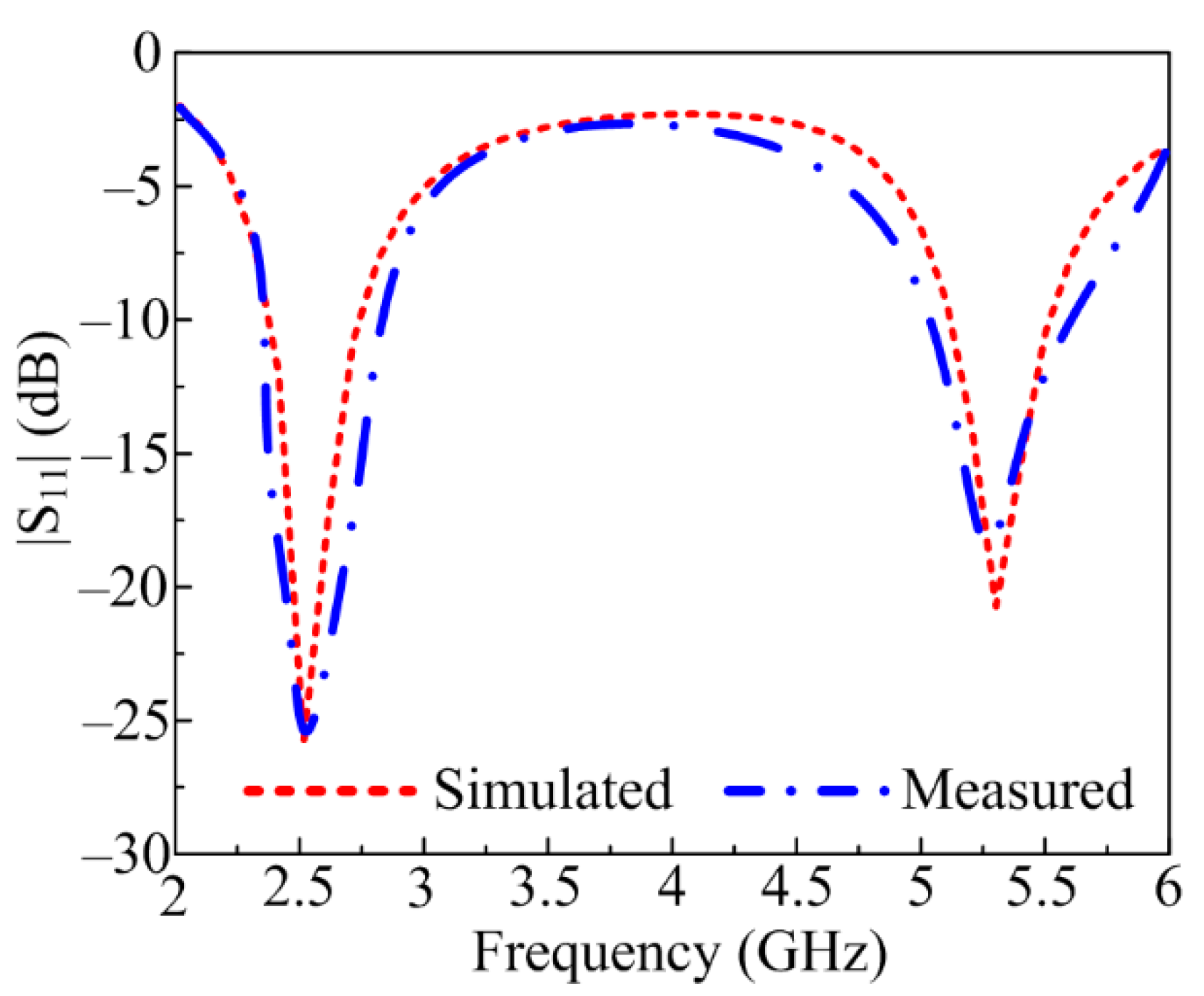
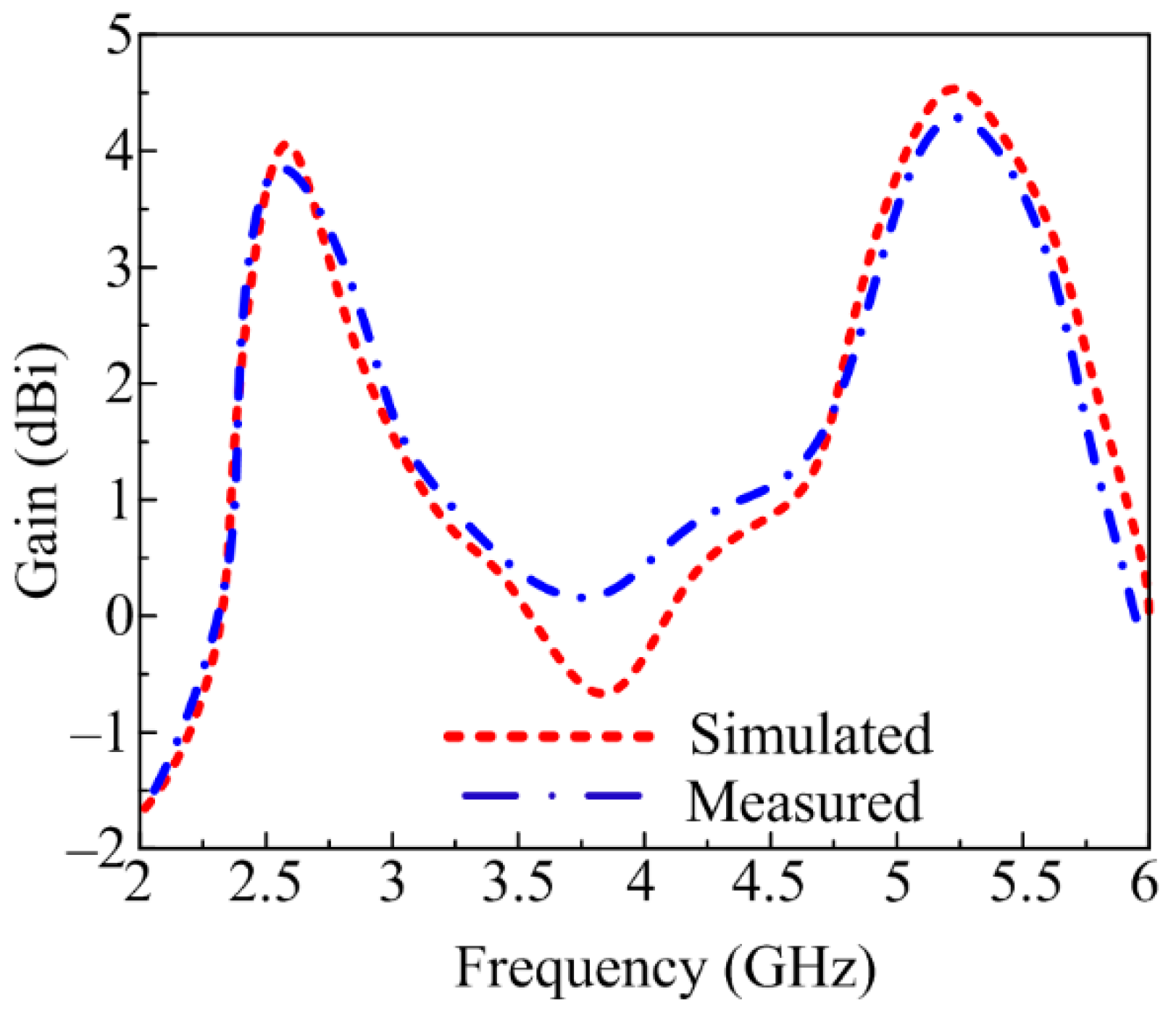

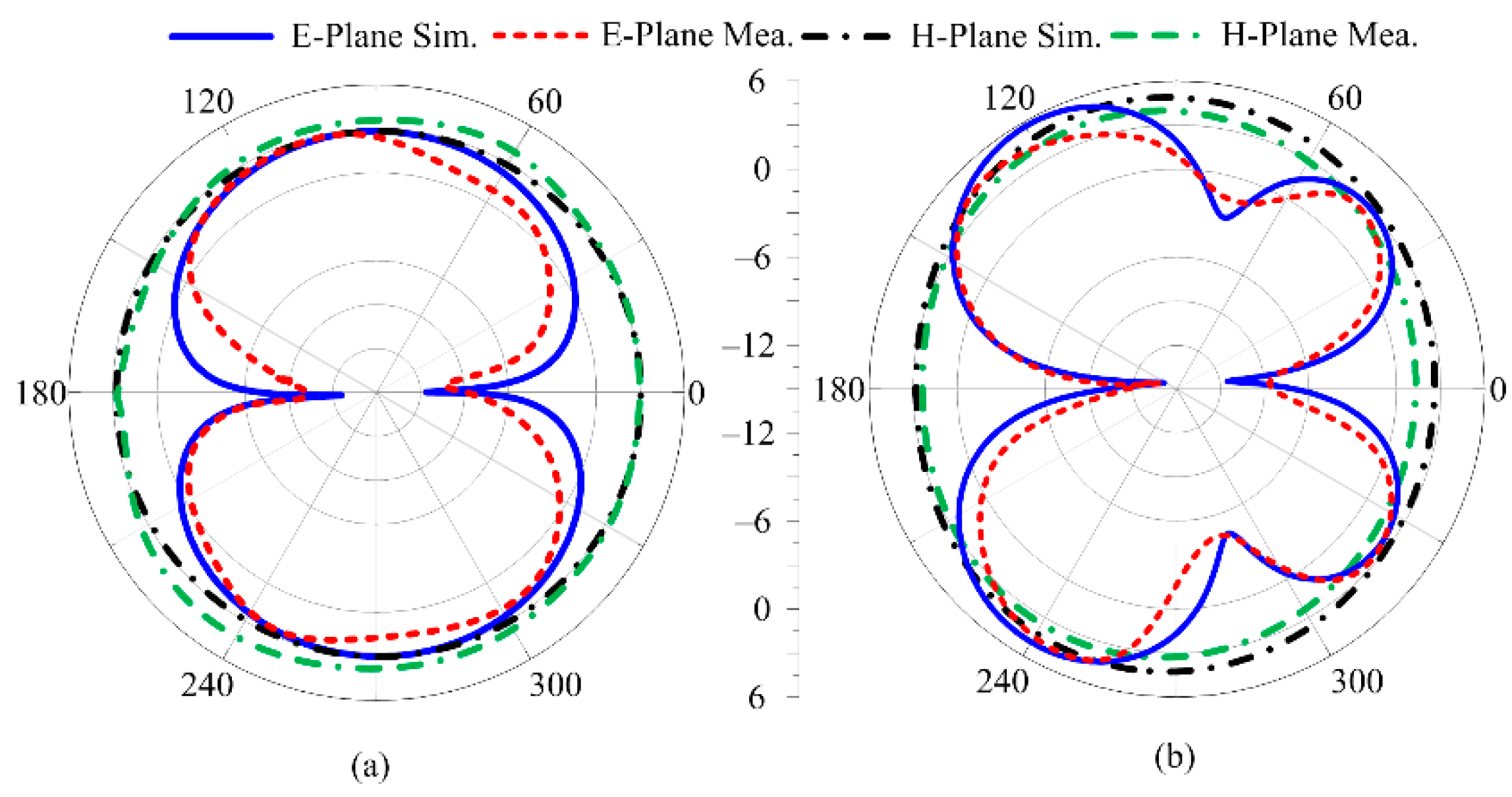
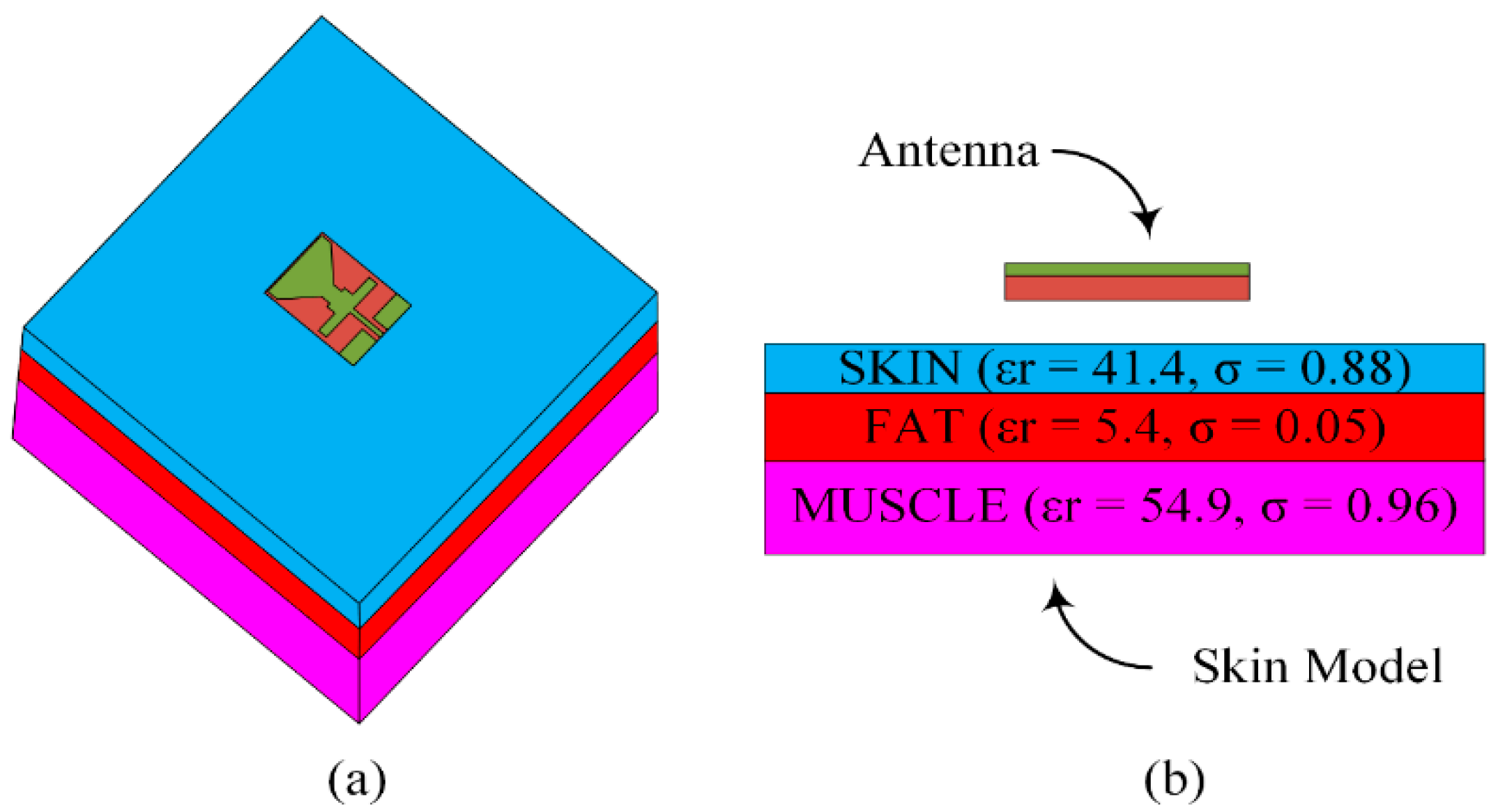
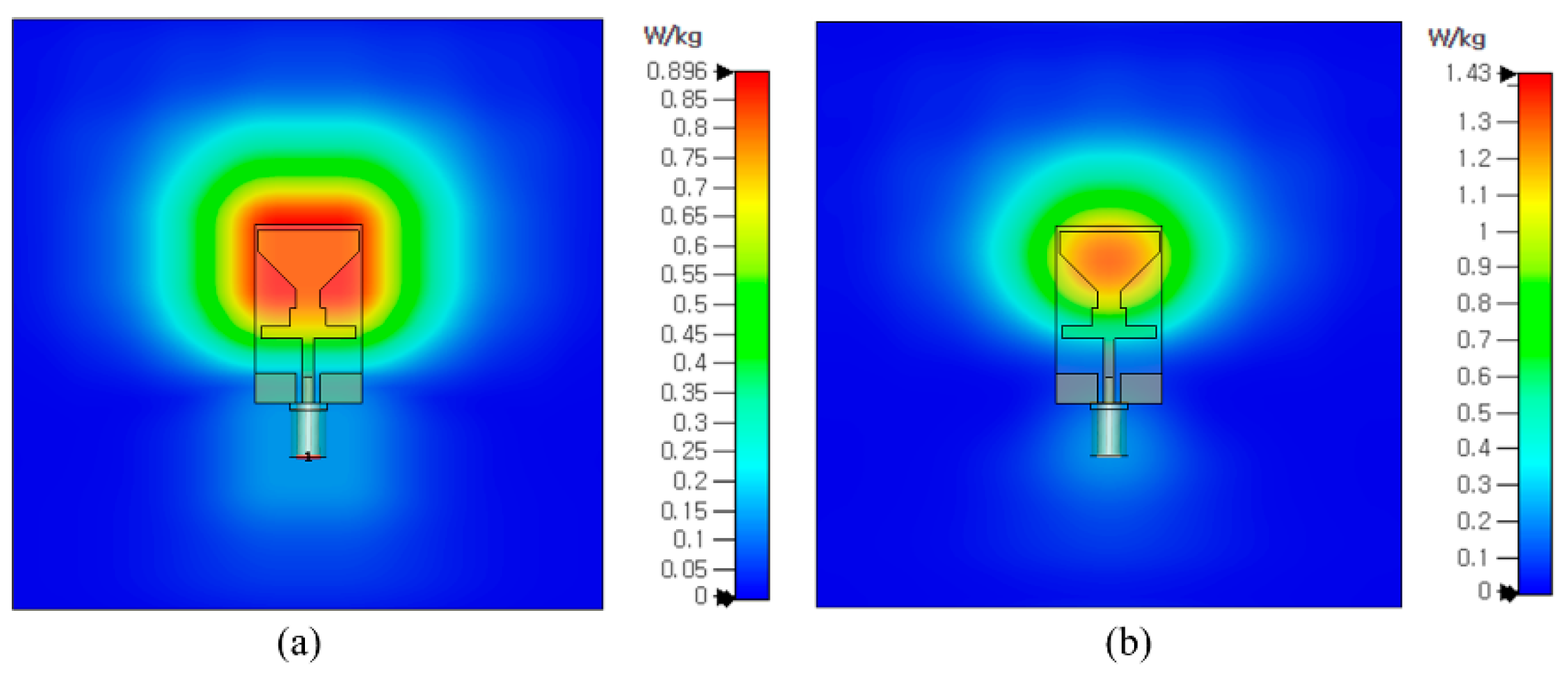
| Ref | Size (mm3) | Operational Mode | Resonant Frequency (GHz) | Operational Bandwidth (GHz) | Gain (dBi) | Radiation Efficiency (%) |
|---|---|---|---|---|---|---|
| [5] | 60 × 80 × 3 | Single | 2.42 | 2.37–2.44 | 8.68 | - |
| [6] | 200 × 15 × 3 | Single | 2.3 | 2.2–2.57 | 8.5 | - |
| [7] | 45 × 42 × 1.27 | Single | 2.7 | 2.38–3.1 | 4.8 | - |
| [8] | 40 × 10 × 1.6 | Single | 2.4 | 2.38–2.43 | 1.34 | 79 |
| [9] | 38 × 33.2 × 1.5 | Single | 2.4 | 2.37–2.43 | 1 | - |
| [10] | 40 × 30 × 1.6 | Single | 2.4 | 2.2–2.73 | 3.28 | - |
| [11] | 76 × 57.2 × 1.6 | Single | 2.4 | 2.38–2.42 | 3.1 | - |
| [12] | 30 × 25 × 3.2 | Single | 5.2 | 5.1–5.32 | 6.3 | - |
| [13] | 142 × 60 × 0.5 | Single | 5.2 | 5.17–5.26 | 4.5 | - |
| [14] | 16 × 19 × 1.6 | Single | 5.38 | 5.35–5.4 | 5.83 | - |
| [15] | 55 × 52 × 1.57 | Single | 5.2 | 5.1–5.3 | 6.2 | - |
| [16] | 32 × 28 × 1.6 | Dual | 2.4/5.2 | 2.3–2.5/4.9–6 | - | - |
| [17] | 14.5 × 14 × 1.6 | Single | 5.2 | 5–5.3 | 3.3 | 41.7 |
| [18] | 42 × 36 × 2.4 | Dual | 2.4/3.3 | 2.2–2.45/3.3–3.45 | 4.6/4.2 | - |
| [19] | 18 × 17 × 4 | Dual | 2.4/5.2 | 2.4–2.48/5.15–5.35 | 4.1/1.4 | - |
| [20] | 44.5 × 44.5 ×1.6 | Dual | 2.4/5.8 | 2.2–2.4/5.7–5.9 | 4.8/4.7 | - |
| [21] | 100 × 100 × 0.8 | Dual | 2.3/5.2 | 2.4–2.6/4.9–5.3 | 4.8/5.7 | 70/70 |
| [22] | 74 × 27 × 17 | Dual | 2.4/5.4 | 2.34–2.5/5.06–5.9 | 3.8/6.8 | - |
| This Work | 30 × 18 × 0.79 | Dual | 2.4/5.4 | 2.25–2.8/5–5.65 | 3.9/4.8 | 92/94 |
Disclaimer/Publisher’s Note: The statements, opinions and data contained in all publications are solely those of the individual author(s) and contributor(s) and not of MDPI and/or the editor(s). MDPI and/or the editor(s) disclaim responsibility for any injury to people or property resulting from any ideas, methods, instructions or products referred to in the content. |
© 2023 by the authors. Licensee MDPI, Basel, Switzerland. This article is an open access article distributed under the terms and conditions of the Creative Commons Attribution (CC BY) license (https://creativecommons.org/licenses/by/4.0/).
Share and Cite
Ali, E.M.; Awan, W.A.; Naqvi, S.I.; Alzaidi, M.S.; Alzahrani, A.; Elkamchouchi, D.H.; Falcone, F.; Alharbi, T.E.A. A Low-Profile Antenna for On-Body and Off-Body Applications in the Lower and Upper ISM and WLAN Bands. Sensors 2023, 23, 709. https://doi.org/10.3390/s23020709
Ali EM, Awan WA, Naqvi SI, Alzaidi MS, Alzahrani A, Elkamchouchi DH, Falcone F, Alharbi TEA. A Low-Profile Antenna for On-Body and Off-Body Applications in the Lower and Upper ISM and WLAN Bands. Sensors. 2023; 23(2):709. https://doi.org/10.3390/s23020709
Chicago/Turabian StyleAli, Esraa Mousa, Wahaj Abbas Awan, Syeda Iffat Naqvi, Mohammed S. Alzaidi, Abdullah Alzahrani, Dalia H. Elkamchouchi, Francisco Falcone, and Turki E. A. Alharbi. 2023. "A Low-Profile Antenna for On-Body and Off-Body Applications in the Lower and Upper ISM and WLAN Bands" Sensors 23, no. 2: 709. https://doi.org/10.3390/s23020709
APA StyleAli, E. M., Awan, W. A., Naqvi, S. I., Alzaidi, M. S., Alzahrani, A., Elkamchouchi, D. H., Falcone, F., & Alharbi, T. E. A. (2023). A Low-Profile Antenna for On-Body and Off-Body Applications in the Lower and Upper ISM and WLAN Bands. Sensors, 23(2), 709. https://doi.org/10.3390/s23020709








